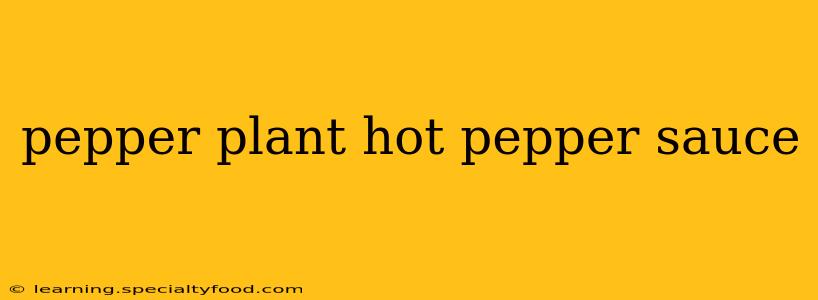The vibrant world of hot sauces offers endless possibilities, and few are as rewarding as crafting your own pepper plant hot pepper sauce. This guide dives deep into the process, from selecting the perfect peppers to bottling your fiery creation, ensuring you achieve a product that's both delicious and impressive. We'll explore various aspects, addressing common questions and providing tips for achieving the perfect heat and flavor profile.
What are the best peppers for hot pepper sauce?
The choice of pepper dictates the heat and flavor of your sauce. While countless varieties exist, some stand out for hot sauce making:
- Habaneros: Offer a fruity sweetness balanced with intense heat.
- Scotch Bonnets: Known for their fiery heat and smoky flavor.
- Ghost Peppers (Bhut Jolokia): Extremely hot, requiring careful handling and often used sparingly.
- Serranos: Provide a good balance of heat and flavor, making them versatile choices.
- Jalapeños: Milder heat, perfect for those who prefer less intense spice.
Consider blending different peppers to achieve a unique flavor profile; for instance, combining habaneros with a milder pepper like a bell pepper can create a complex taste with manageable heat.
How do I make hot pepper sauce from my pepper plants?
Making hot pepper sauce is a rewarding process, and the steps are relatively straightforward:
- Harvesting: Pick peppers at their peak ripeness for optimal flavor and heat. The color will vary depending on the pepper type.
- Cleaning: Wash peppers thoroughly to remove dirt and debris. Wear gloves to avoid skin irritation, especially with hotter varieties.
- Preparing: Remove stems and any damaged parts. You can roughly chop or leave them whole depending on your desired texture.
- Cooking: Boil peppers in water for about 10-15 minutes to soften them. This also helps extract the capsaicin, the compound responsible for the heat.
- Blending: Blend the cooked peppers with your preferred ingredients – vinegar, salt, garlic, onions, etc. Experiment with different combinations for unique flavors!
- Straining (Optional): If you prefer a smoother sauce, strain the blended mixture through a fine-mesh sieve to remove seeds and skins.
- Bottling: Once the sauce is cooled, carefully transfer it to sterilized bottles or jars.
How long does homemade hot pepper sauce last?
Properly stored, homemade hot pepper sauce can last for several months, even up to a year. Acidic ingredients like vinegar help preserve the sauce. Store it in a cool, dark, and dry place. Refrigeration is highly recommended to prolong shelf life and maintain quality.
What are some variations to try?
The beauty of homemade hot pepper sauce lies in its versatility. Experiment with different flavors by adding:
- Fruits: Mangoes, pineapple, or peaches add sweetness and complexity.
- Herbs: Cilantro, oregano, or thyme offer aromatic notes.
- Spices: Cumin, coriander, or smoked paprika add depth.
Can I use different types of vinegar in my hot pepper sauce?
Yes, different vinegars impart different flavors:
- White Vinegar: A neutral flavor, ideal for letting the pepper's flavor shine through.
- Apple Cider Vinegar: Offers a subtle sweetness and tanginess.
- Red Wine Vinegar: Adds a fruity and slightly tart flavor.
Remember to always prioritize safety when handling hot peppers. Wear gloves, and avoid touching your eyes or face after handling them. Experiment, have fun, and enjoy the delicious results of your homemade pepper plant hot pepper sauce!
